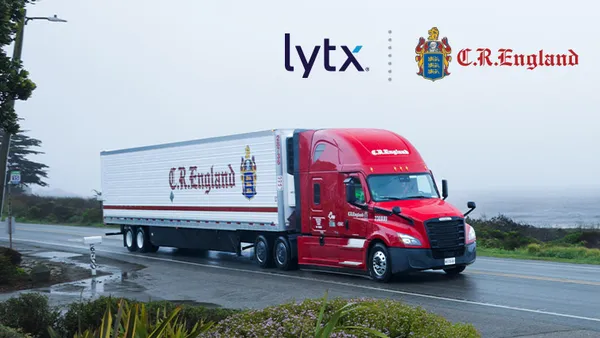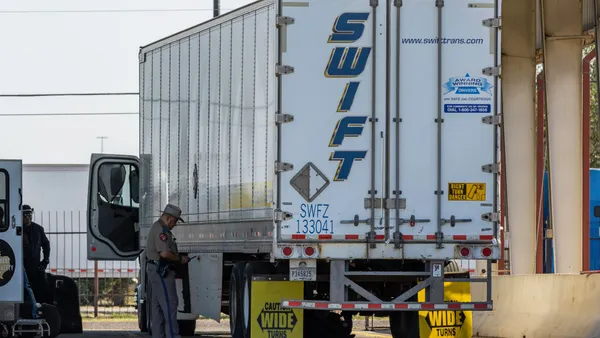Truck Driver Appreciation Week has been a little different this year — just like everything else in the world.
The usual BBQs and buffets were few and far between. The clinking of beer glasses in camaraderie is on hold until next year. Prize raffles and appreciation events happened online or as a quick drive-by, rather than an extended in-person celebration.
The event also takes on special meaning this year. The truck driving profession gained national attention with the pandemic, as consumers cheered the essential workers hauling everything from their e-commerce parcel to truckloads of grocery inventory.
"Drivers like to be recognized and appreciated as much as anything, and more than one week a year," said Kelly Garland, founder of Garland Source, a recruiting firm for transportation management careers.
But even as Americans nationwide thanked the truckers, drivers left the ranks. Some because of low rates in the spring. Others because they were approaching retirement age. And others because they wanted to go home every night to their family, and a construction job was better suited to that desire than driving cross country and hoping truck stops would be open for a bite to eat or a shower.
Now loads are spiking, capacity is tightening and fleets need to win drivers back for the long haul. A once-a-year raffle won't cut it.
But here's what might:
Make life easier, better, safer
DHL started using a relay approach for longer routes, said Jim Monkmeyer, president of transportation at DHL Supply Chain North America.
Drivers transport the freight for one leg, then hand it off to the next driver and return home for the night. That minimizes the time drivers spend away from home, a key reason for turnover in the industry.
Adopting safety tech is another way "to show appreciation for the workforce year-round," Monkmeyer told me. DHL uses tech like in-cab telematics (although this can be controversial among drivers), digital routing and data to eliminate hours waiting to unload.
Prove their opinions matter
WorkHound data shows only 30% of employees strongly agree their opinions at work count.
"Why not take a more sustainable approach with continuous, real-time communication?" WorkHound posited in a document on Truck Driver Appreciation Week. "Take the lead on retention and appreciation by bridging the gap."
Listening, and continuously acting on that feedback, can make a difference in how drivers perceive their value in a company.
Garland suggested a scorecard drivers can use to rate their experience at a terminal or a maintenance facility.
"In doing this, the company gives the driver recognition that their voice and opinions count, assuming [negative] areas are addressed," Garland said.
Monkmeyer said DHL continuously adapts its policies based on the feedback from drivers.
Make it personal
This is an area where smaller fleets have the advantage, because they can really get to know their drivers, Garland told me.
Go beyond the generic gift card or company jacket. If the driver loves to go fishing, "give them a rod, tackle, or a guided fishing outing," Garland said.
Big fleets can get personal too, such as by sending a birthday card to the driver's family while the driver is on the road.
"Those little things make a driver feel like they are a part of a family," Garland said.
WorkHound suggested handwritten notes showing appreciation for drivers working through uncertain and dangerous conditions, especially this year.
Pay more
Last but absolutely not least, pay a good wage.
Schneider said it's offering an additional performance pay program for drivers. On top of the standard performance pay program, drivers could earn up to $700 more.
The pay issue goes beyond this, though, and it may be a structural problem.
The average annual wage for a tractor-trailer truck driver is about $47,000, according to the Bureau of Labor Statistics — about $6,000 less than the average wage for all occupations.
Per-mileage pay means drivers could sit for hours at shipper and receiver facilities, running the clock yet not making a dime.
Many executives lamented they couldn't bring back drivers as volumes started to spike in the summer. They blamed myriad factors, from training school closures to alternative industries hiring workers, such as in construction.
But one of the most frequently cited factors was federal benefits, giving drivers an "incentive" to stay home.
If your pay structure means a driver can earn a better wage sitting at home than hauling for your company, it's time to take a good, hard look at your payrolls.
Drivers do a critical job, for your business and the greater public. Their pay should reflect that, or they won't have much motive to fill the truck driving ranks.













